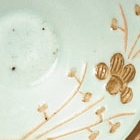J.J. Lally & Co., Oriental Art / New York City, New York
MenuPast Exhibition
SONG DYNASTY CERAMICS:
The Ronald W. Longsdorf Collection
March 15 - April 13, 2013
26.
A JIANGXI BAISHE PORCELAIN ‘MOON AND PRUNUS’
CONICAL TEA BOWL
Song Dynasty (A.D. 960-1279)
decorated on the interior with a blossoming prunus spray and a crescent moon carved through the pale bluish Qingbai type glaze and painted in reddish-brown, the narrow flaring lip also dressed in brown slip above the ‘finger groove’ indented around the exterior, the sides tapered down to a small ring foot enclosing a countersunk base, the lower sides left unglazed revealing the white porcelain body.
Diameter 4 1⁄4 inches (10.8 cm)
A bowl of the same form and design is illustrated by Krahl, Chinese Ceramics from the Meiyintang Collection, Volume One, London, 1994, p. 278, no. 515, where it is noted that similar wares with a light blue Qingbai glaze applied over a slip have been excavated at the Baishe kilns in Nanfeng county, Jiangxi province. A similar small conical bowl excavated at Baishe is illustrated in Kaogu, 1985, No. 3, pl. 6: 1 & 2, and in a line drawing on p. 226, fig. 4:1. Another very similar Baishe ‘moon and prunus’ tea bowl from the Turner Collection, now in the Columbia Museum of Art, Columbia, North Carolina, is illustrated in Eye to the East: The Turner Collection of Chinese Art, Columbia, 2008, p. 64. Compare also the ‘moon and prunus’ tea bowl of this type, unearthed in 1979 at Nancheng county, Jiangxi province, illustrated by Zhang (ed.) in Zhongguo chutu ciqi quanji (14) Jiangxi (Complete Collection of Ceramic Art Unearthed in China, Vol. 14, Jiangxi Province), Beijing, 2008, p. 75, no. 75, described as “made in the Jiangxi Nanfeng Baishe kiln.”
During the Song dynasty, the transitory beauty of the flowering plum (mei hua) was a theme which inspired many Chinese poets and painters, and the mei hua motif acquired a special relevance and widespread popularity in the arts of the Southern Song period. In a chapter on literary and cultural traditions, under the heading ‘The Flowering Plum in Southern Song’ in Bones of Jade, Soul of Ice: The Flowering Plum in Chinese Art by Bickford, New Haven, 1985, pp. 26-28, the author points out that the popularity of the mei hua theme in the Song dynasty coincides with the retreat of the Song court to the south, and by “Choosing Hangzhou as their capital for strategic reasons, the Song court happened to settle in the heartland of the flowering plum tradition.” Bickford goes on to say “… the upheaval of the Northern-Southern Song transition and the political vulnerability of the Southern Song gave added resonance to the theme of transience embodied in falling plum blossoms. The flowering-plum aesthetic of plain elegance suited the ultrarefined taste of the Song elite …”
宋 江西白舍窯剔花梅月紋盞 徑 10.8 厘米
